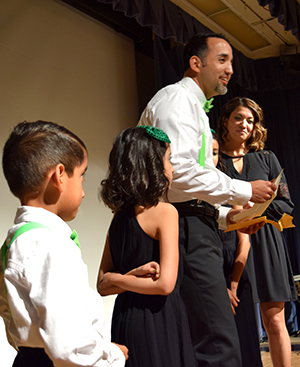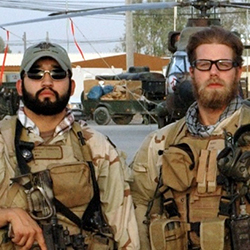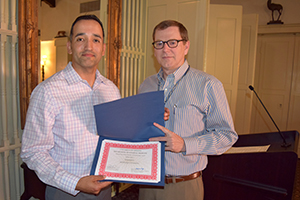Headed for an internal medicine internship and dermatology residency training program as a physician after graduation, Jose “Anthony” Cervantes has had a lot of “enablers” in his life—but, for him, that’s a good thing.
 The long list of people he has to thank at his May 11 convocation as a UA College of Medicine – Tucson graduate enabled him to rise from poverty on both sides of Laredo, a border town along the Texas-Mexico border where he was born on the U.S. side and lived on the Mexico side for four years. Neither of his parents graduated high school. At age 5, Cervantes’ family moved to Houston and, at age 9, to Bakersfield, Calif., where his father, a printer by trade, worked several different jobs to provide for him and his younger sister. It was there that his father met his stepmother Yvette, who helped raise him. It’s also where Cervantes met his wife, Jess, later while on military leave. In 2000, he graduated high school early to join the U.S Air Force in hopes of becoming a Pararescue jumper.
The long list of people he has to thank at his May 11 convocation as a UA College of Medicine – Tucson graduate enabled him to rise from poverty on both sides of Laredo, a border town along the Texas-Mexico border where he was born on the U.S. side and lived on the Mexico side for four years. Neither of his parents graduated high school. At age 5, Cervantes’ family moved to Houston and, at age 9, to Bakersfield, Calif., where his father, a printer by trade, worked several different jobs to provide for him and his younger sister. It was there that his father met his stepmother Yvette, who helped raise him. It’s also where Cervantes met his wife, Jess, later while on military leave. In 2000, he graduated high school early to join the U.S Air Force in hopes of becoming a Pararescue jumper.
Anthony and family (above) at Match Day 2017 in DuVal Auditorium.
PJs, as they call themselves, train alongside Special Forces and Navy Seal candidates and also undergo training as medics—for two years before they’re allowed to deploy. They can be called at any moment to help rescue wounded servicewomen and men in battle, which he did sometimes 4-6 times a night during multiple deployments to Afghanistan, Iraq and Africa. Or they can be called in to rescue civilians during humanitarian operations such as after Hurricane Katrina hit New Orleans in 2005. Among PJs on the first two Air Force helicopters to reach the city, Cervantes helped rescue more than 200 people from rooftops, attics and upper floors of apartments in the week that followed that natural disaster.
“We treated a lot of people who were dehydrated and folks who were very sick—diabetics, things like that. We just pulled folks out and took them to different places—the airport, hospitals, the Superdome and a ‘cloverleaf,’ where the highways converged and Greyhound buses would take them away to Houston or Dallas,” Cervantes said.
Other civilian operations he has served in include maritime rescues, such as if a sailor suffered an appendicitis on a ship far out in the Pacific Ocean. “A Coast Guard cutter might not be able to get to him for 14 hours, so we would get called on these missions. We’d fly out, jump into the ocean, get on their vessel, stabilize him and, then, our helicopter would come in and we’d take him to the Coast Guard vessel” or elsewhere for treatment. He’s also done foreign missions as cooperative partnership training, such as one in Chile with special forces from there, Argentina and Uruguay. “That was good.”
While serving as a PJ instructor at Lackland Air Force Base, Cervantes earned his undergrad in pre-biology taking night classes at the University of Texas San Antonio. He applied to medical school here, in part, because his family lived in Tucson when he was stationed at Davis-Monthan Air Force Base and it’s the home of the 306th Rescue Squadron— one of only a few Reserve Pararescue units in the country. It’s also where a friend , Joshua Appel, MD, a fellow PJ for whom a rescue mission in Afghanistan was the basis of the Hollywood movie, Lone Survivor, serves as an associate professor in the UA Department of Emergency Medicine.
, Joshua Appel, MD, a fellow PJ for whom a rescue mission in Afghanistan was the basis of the Hollywood movie, Lone Survivor, serves as an associate professor in the UA Department of Emergency Medicine.
Cervantes (left) with Dr. Appel (2nd from right) and comrades in Afghanistan.
“We’re good buddies. Josh and I were deployed at the same time in Afghanistan but in different units. We did conduct a mission together once on that deployment. Afterward, we’d stayed in kind of loose contact. He’s been a mentor here, for sure. At one point, early on, I thought I wanted to do Emergency Medicine. We work at the same Reserve unit. Every month, I see him. He’s a great guy,” Cervantes said.
 The timing for the move to medical school was right, too, because he had just been named a 2013 Pat Tillman Scholar by the Pat Tillman Foundation.
The timing for the move to medical school was right, too, because he had just been named a 2013 Pat Tillman Scholar by the Pat Tillman Foundation.
He speaks highly of other mentors he has had at COM – Tucson, including UA Surgery Professor Bill Rappaport, MD; current and former dermatology faculty Vivian Shi, MD, and Nathalie Zeitouni, MD; and Associate Dean of Student Affairs Violet Siwik, MD. Among others he wants to thank for putting their faith in him along the way—beyond his wife and mom, of course—is whoever approved his application four years ago.
Anthony and fellow PJ and Pat Tillman Scholar Dave Glass (right), who met during rescue operations in New Orleans after Hurricane Katrina and were teammates in the 48th Rescue Squadron in Afghanistan and Iraq. The two were a team again April 22 in the Pat's Run 4.2 mile road race in Tempe, Ariz., to raise money for the Pat Tillman Foundation.
“When I literally think about all the people whose lives have touched mine along the way to get me to where I am today—I’m just like blown away,” Cervantes said. “I still get chills even now. Everyone that’s enabled me. Everyone that’s put their trust in me. Everyone that said, ‘Hey, we believe in you. We’re gonna put you in this position.’ Or even with the College of Medicine here, I didn’t have a perfect resumé to go into medical school. But they were able to see some things that maybe were apparent. Maybe, they saw I was committed to becoming a physician, had served and, for whatever reason, they chose to put their trust in me.”
 He also has a soft spot for Lucy Contreras (at left in her office with Anthony), the UA Department of Medicine clerkship coordinator, who rearranged his schedule so he could train monthly with the 306th Pararescue team and when one of his medical rotations was interrupted by a call in October 2015 to rescue a man hiking in the Huachuca Mountains who suffered a heart attack at 9,000 feet. Last summer, he sent her a YouTube link to an Air Force Reserves video of him talking about being a PJ—not to brag, he says, but to thank her.
He also has a soft spot for Lucy Contreras (at left in her office with Anthony), the UA Department of Medicine clerkship coordinator, who rearranged his schedule so he could train monthly with the 306th Pararescue team and when one of his medical rotations was interrupted by a call in October 2015 to rescue a man hiking in the Huachuca Mountains who suffered a heart attack at 9,000 feet. Last summer, he sent her a YouTube link to an Air Force Reserves video of him talking about being a PJ—not to brag, he says, but to thank her.
“It was just my way of telling her that what she does as a coordinator, juggling schedules and making accommodations to allow me to train directly impacted our community because a couple of weeks later I was in the mountains hoisting this guy a hundred feet into a helicopter. And we actually brought him to the Banner – UMC roof here. No one knew me because I was in military uniform,” he said. “It was my way of saying, ‘What you do is important.’”
In the video (at right), Cervantes underscores the PJ creed: “These Things We Do That Others May Live.”
As to why dermatology and not emergency medicine, Cervantes said, “I learned early on Emergency Medicine wasn’t my emergency medicine. When you’re out there in a forward battle space, you do it all. You do everything. Here, it’s a different setting. Trauma surgeons have a huge part of that pie. Emergency Medicine is just a small part. And I found, often, people use the ER as a means to get primary care. Don't get me wrong—it's important work. But having done some of that at a different level and a different scope of practice, it wasn’t what I thought. Then, I started exploring what some of my goals were and my personality, and I found that I loved outpatient medicine.”
He enjoyed being in clinic, having one-on-one consults where you could be more thoughtful about a patient's condition and the diagnosis to address it. He considered family medicine and pediatrics, and then discovered dermatology during a third-year rotation in medical school. He spoke about observing Jason DuPont, MD, a UA clinical associate professor, do surgery at the UA Cancer Center’s Peter and Paula Fasseas Clinic at 3838 N. Campbell Ave.
“My goal is to ultimately be a Mohs surgeon like him," Cervantes said. "They basically excise melanomas and difficult skin cancers that the dermatologist can’t do in his office. This includes complicated lesions of the face, neck and other tissue-sparing areas. It’s just a great balance of one-on-one outpatient visits and surgery.”
 On May 4, UA professor and Division of Dermatology Chief James Sligh, MD, PhD, presented Cervantes (at left) with Dermatology’s Outstanding Medical Student Award at the UA Department of Medicine’s Annual Awards Assembly. Cervantes thanked Dr. Sligh and Kevin Moynahan, MD, COM – Tucson deputy dean for education and a professor in the Division of Geriatrics, General Internal Medicine and Palliative Medicine, for their advice as he was making his decision on where to go next.
On May 4, UA professor and Division of Dermatology Chief James Sligh, MD, PhD, presented Cervantes (at left) with Dermatology’s Outstanding Medical Student Award at the UA Department of Medicine’s Annual Awards Assembly. Cervantes thanked Dr. Sligh and Kevin Moynahan, MD, COM – Tucson deputy dean for education and a professor in the Division of Geriatrics, General Internal Medicine and Palliative Medicine, for their advice as he was making his decision on where to go next.
After graduation, Cervantes will do a medical internship in internal medicine at Tucson Medical Center and, then, he’s off to the University of Texas at Austin’s Dell Medical School and its LIVESTRONG Cancer Institutes for his residency training in dermatology. There, his family—including two girls and a boy, ages 11, 8 and 6—will be closer to his mom, who still lives in Houston.
ALSO SEE:
“Best in Class: Grads Saving, Improving Lives” | UA News, Posted May 10, 2017
“Forty Honored at 2017 DOM Annual Awards at Arizona Inn” | Posted May 6, 2017
“Clerkship Coordinator Contreras among UAHS Excellence Award Nominees” | April 12, 2017
“See Where UA Med Students Will Do Their Residency Training per Match Day 2017” | Posted March 17, 2017
* Cervantes notes that his sister also has graduated from college, being the first woman in his family with that achievement.


